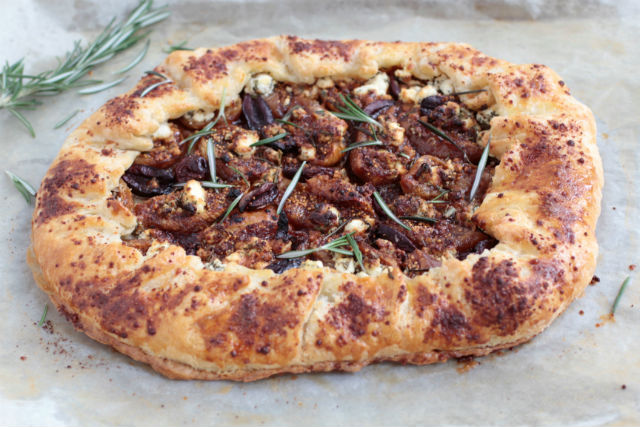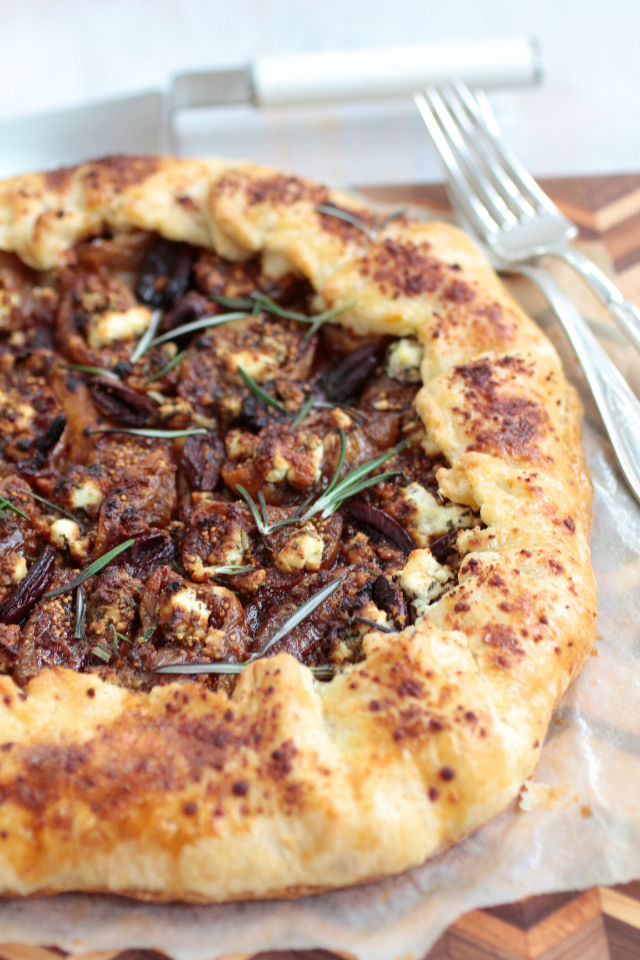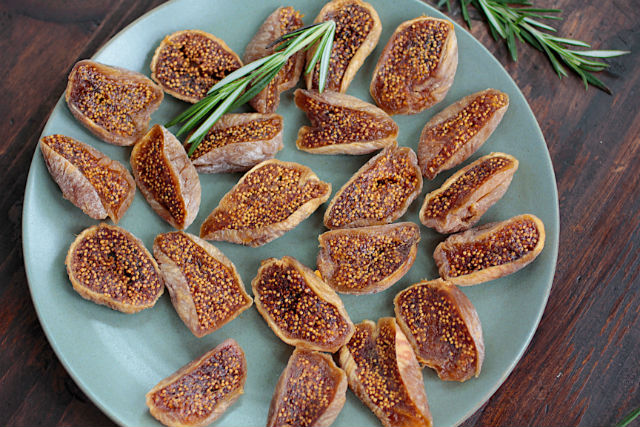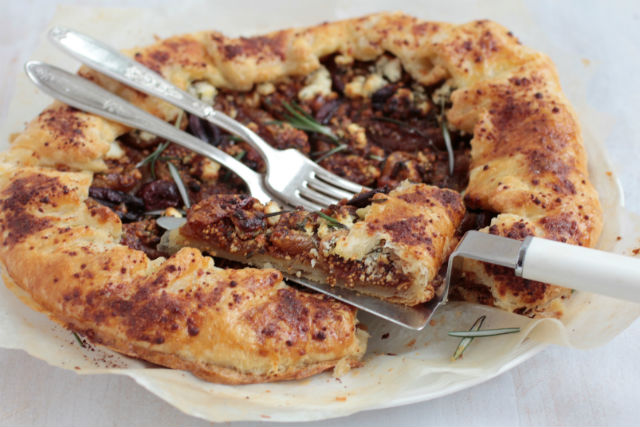Cooking creatively to celebrate Tu Bishvat is a little like peeking into a mystery basket of unrelated elements on CHOPPED and wondering: now what?
Except that the ingredients we celebrate on this holiday are related because they are the seven edible species mentioned most frequently in the Bible (Deut.8:8). So our challenge is to find a way to bring figs, grapes, pomegranates, olives, dates, wheat and barley to the festive meal as we celebrate their abundance in Israel.
With the beginning of starting on a Sunday evening this year, there’s no reason to rush this easy baking project on a leisurely winter day. You’ll need to chill the dough for this sweet and savory galette for at least an hour while you assemble the other ingredients. Consider your mission accomplished when you taste the results of including four of the seven ingredients in this symbolic pastry wrapped treat. Rather than omitting the one savory element (olives) choose to seek balance with the sweet elements by adding additional umami with grated parmesan cheese around the crimped folds. Silan (date honey) adds a complex level of sweetness to the layer of luscious sliced figs.
The Nosher celebrates the traditions and recipes that have brought Jews together for centuries. Donate today to keep The Nosher's stories and recipes accessible to all.
Use as much salt and pepper as you like to season the goat cheese. I like a good amount of cracked black pepper to heat up the mild cheese. Goat cheese is not mentioned as one of the seven species but we know that goats roamed the hills of ancient Israel, so why not?
Goat Cheese, Silan and Olive Galette
Ingredients
For the dough:
1 1/2 cups unbleached all-purpose flour plus 2 Tbsp for rolling out dough
1 1/2 sticks unsalted butter, chilled, cut into 1/2 inch pieces
1/4 tsp salt
1/3 cup ice water plus 3-4 Tbsp
For the galette filling:
2 oz goat cheese, crumbled
1 Tbsp minced fresh rosemary
salt and pepper to taste
12 dried figs
12 Kalamata black olives
12 Tbsp silan (date honey) or honey
1 egg yolk mixed with 1 Tbsp cold water
1 Tbsp parmesan cheese, grated
1 tsp butter for cookie sheet
Directions
To make the dough:
Set aside 2 Tb. flour for rolling dough after it is chilled.
Place 1 1/2 cups flour, butter and salt in food processor and pulse 46x to mix ingredients.
Slowly add ice water to flour mixture and pulse until dough holds together. Gradually add additional water (13 Tbsp), one Tb. at a time, if dough is too crumbly. Dough will not be fully mixed so expect to see pebble size bits of butter. (This is a good thing).
Remove from processor and wrap in plastic wrap, flattening ball into a disc with your hands. Refrigerate 24 hours before using.
To make the galette:
While the dough is chilling, crumble goat cheese and season with rosemary, salt and pepper.
Slice figs in half through the long side so that lots of seeds show.
Soak fig halves in hot water for 30 mins. Remove from water and place on paper towel lined plate. Pat dry.
Drain olives in a colander (do not rinse), pat dry and slice in half.
Butter cookie sheet and dust with a bit of flour.
Prepare cold work surface (slab of marble or granite countertop) by sprinkling lightly with flour.
Dust rolling pin lightly with flour.
Remove dough from refrigerator, unwrap and roll it out until it is round ('ish) and 1/4 inch thin.
Gently lift rolled dough and place on prepared cookie sheet.
Leaving a 2 inch border between filling and edge of dough, arrange figs in concentric circles on dough.
Sprinkle with goat cheese and olives.
Drizzle with silan or honey.
Bring border of dough towards center of galette, folding it as you move along the circle (or oval), crimping as you go along. Rustic is fine and prettier than perfect so don't stress over crimping perfectly. The center of the galette will be open.
Brush border with egg mixture and sprinkle with parmesan.
Bake at 400 degrees Fahrenheit until golden.
Serve immediately.
Love Jewish food? Sign up for our weekly Nosher recipe newsletter!







